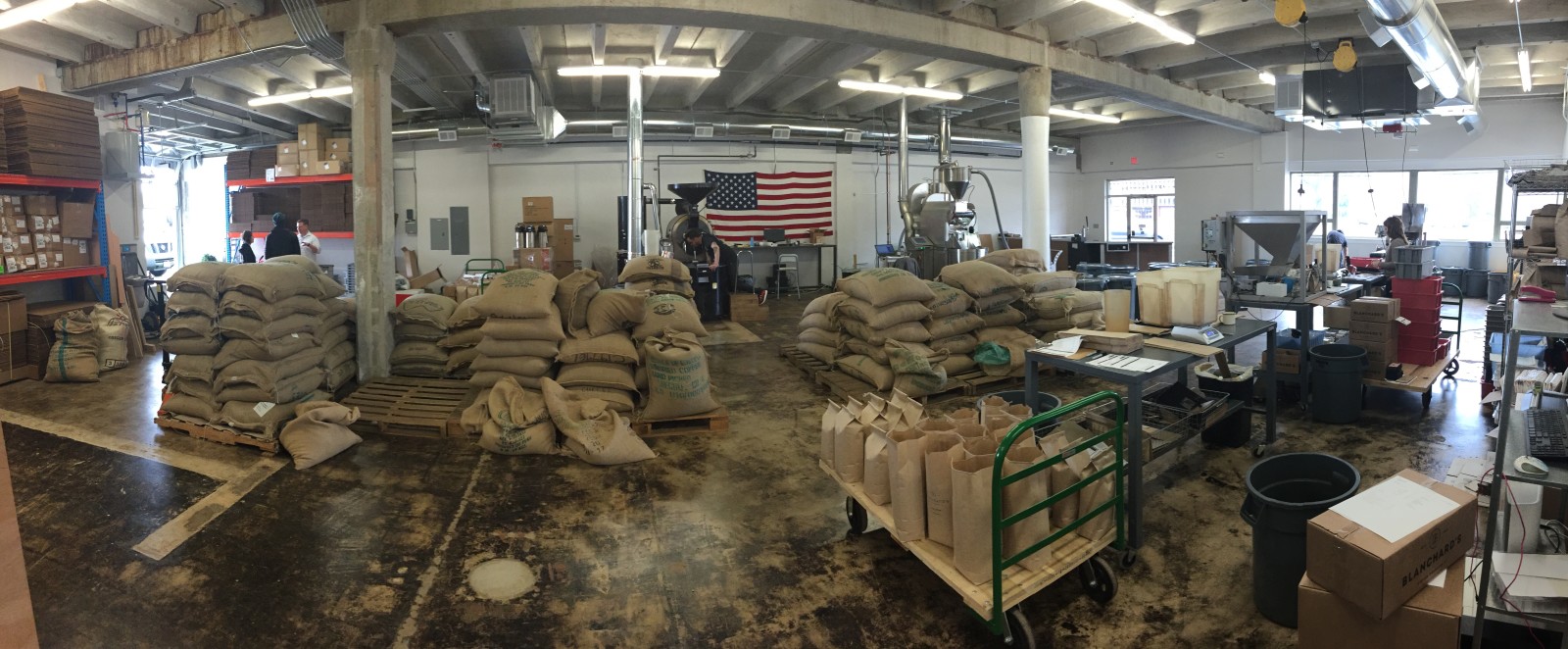Inside Blanchard’s new coffee roasting lab and socially-conscious business model
One of the latest businesses to make the move to Scott’s Addition is growing just about as fast as its new neighborhood.

Blanchard’s Coffee, which was bursting at the seams in Manchester, has expanded not only its footprint but its offerings at its new home on Westwood Avenue.
The new coffee roasting lab is almost double the size of its Manchester counterpart–6,000 square feet versus 2,400–with an additional 2,000 available adjacent to the space for future expansion. And with the company expanding into D.C., Maryland, and the Carolinas (and increasing nationwide sales via its online store), Blanchard’s may need it sooner than later.
Inside the open, warehouse-style facility, around a dozen staffers busily roast coffee beans, fulfill orders, and hand-label retail bags for the company’s many retail distributors, which include Kroger, Martin’s, and smaller retailers around Richmond, plus Whole Foods and Wegmans stores across the state.
Between the grocers and Blanchard’s restaurant clients, the business has to churn out between 6,000 and 7,000 pounds of coffee per week to meet demand. The coffee is roasted on two roasters, five days a week, for six hours per day. After the beans cool off and “rest” for 24 hours, they’re hand-bagged at a rate of about six to eight bags per minute and sent on to their next destination.
A single coffee roasting machine handled all of that roasting up until recently, says Stephen Robertson, Director of Sales and Marketing. “We were hitting our capacity in terms of roast load, so we were running [the original] roaster eight to nine hours a day and it’s not really meant to handle that kind of volume,” he said.
Upon moving into the new space, a newer, larger, more efficient machine was added. It uses indirect heat for a more controlled roasting process that uses less energy than the original. “[The new machine] uses forced air instead of direct heat so you get to kind of reuse all the kinetic energy, and it has computer tracking. This is the heart of our operations.” The original roaster is still in operation next to the new, state-of-the-art machine.
— ∮∮∮ —
So where is it all sourced? Nicaragua, for the most part. Robertson recently visited some Blanchard’s coffee bean vendors in the Central American country to talk with workers, see where the beans are grown, and explore ways to improve working and growing conditions.
“Everything you see is direct source coffee,” Robertson said, pointing to a stack of burlap coffee sacks in the center of the facility. He says visiting the growers and working together on improvements is a win-win for everyone. “[The coffee growers] get more money, we get more control over (product) quality aspects, and it builds this continuous community relationship. We’re really proud of this.”
Staff found during the recent trip that one of the main challenges facing their vendor is the road to the farm is nearly impassible during the rainy season. “So we asked, ‘what is the cost to rebuild the road?’ and discovered it’s just a few thousand dollars.” Blanchard’s is currently in the planning stages of coming up with a way to fund the repaving of the road, which will lead to increased productivity for workers.
Employees also found that the vendor’s kitchen had a dirt floor, which it plans to cover with more suitable flooring. “We can make really impactful decisions that help improve [our vendor’s workers’] livelihoods, and that helps us in the long run, too.”
— ∮∮∮ —
What really sets the Scott’s Addition location apart from Manchester is an expansive room towards the rear of the facility. In it, two state-of-the-art coffee bars stand ready to train clients and members of the public alike on the art of coffee making–something Robertson says was the result of customers asking for advice on roasting and preparing various coffee drinks.
“We’ve always had clients come to us for coffee with varying degrees of ability, so we wanted to create a space where if you said ‘I want to start a coffee shop but i don’t know how to get started,’ you can walk in here and we have the exact equipment you need and can train you on that equipment.”
The space is designed to emulate one of two typical coffee bar scenarios. One bar is a traditional setup with standard machines and mechanisms you’d find in most coffee shops; the other is nothing short of something straight out of any seasoned barista’s dreams.
The latter is outfitted with fully computerized machines that can be programmed to any specification to make the perfect cup of coffee or shot of espresso every time. A client could theoretically come in for training, perfect recipes, then Blanchard’s could upload the recipe to a USB flash drive to be loaded onto the customer’s own equipment in their shop or restaurant.
“We can sit in here in a lab environment and make the very best example of espresso, throw in a jump drive and walk over and plug that in and say, ‘here you go.'”
Robertson says all Blanchard’s staff members will be trained on the lab equipment and certified to provide expert training by mid-year. He hopes that training can be passed on to others, fostering a community of more skilled baristas, better brewed coffee, and, ultimately, increased affinity for the Blanchard’s brand.
“The reason that Starbucks is so successful is that they trained people to like Starbucks,” he says. “That oversimplifies it, but that’s kind of what we want to do; this is why you’re spending a little more for better coffee. You can spend the time to see how it’s made and see the level of science that goes into it.”
— ∮∮∮ —
Inside The Roastery & Lab







-
Recommend this
on Facebook -

Report an error
-

Subscribe to our
Weekly Digest




There are 2 reader comments. Read them.